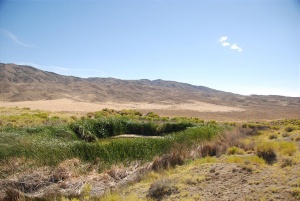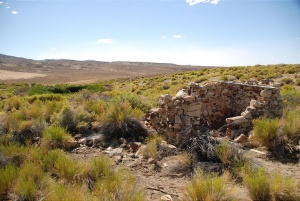Rabbithole Springs: Difference between revisions
m Life Magazine article, p. 80. |
|||
| Line 31: | Line 31: | ||
* [http://contentdm.library.unr.edu/cdm4/item_viewer.php?CISOROOT=/unrart&CISOPTR=302&REC=1 Craig Sheppard's painting, Rabbit Hole Spring] | * [http://contentdm.library.unr.edu/cdm4/item_viewer.php?CISOROOT=/unrart&CISOPTR=302&REC=1 Craig Sheppard's painting, Rabbit Hole Spring] | ||
* H.F. Bonham, Jr., L.J. Garside, R.B. Jones, K.G. Papke, J.Quade, and J.V. Tingle, [http://www.nbmg.unr.edu/dox/of8503.pdf OF1985-03: A mineral inventory of the Paradise-Denio -- and Sonoma-Gerlach Resource Areas, Winnemucca District, Nevada]," p. 126, 1985. | * H.F. Bonham, Jr., L.J. Garside, R.B. Jones, K.G. Papke, J.Quade, and J.V. Tingle, [http://www.nbmg.unr.edu/dox/of8503.pdf OF1985-03: A mineral inventory of the Paradise-Denio -- and Sonoma-Gerlach Resource Areas, Winnemucca District, Nevada]," p. 126, 1985. | ||
* "[http://books.google.com/books?id=W0gEAAAAMBAJ&lpg=PA80&ots=LfTm2TqnIf&dq=bruff%20rabbit%20hole&pg=PA80#v=onepage&q=bruff%20rabbit%20hole&f=false Rigors of the trail: A Traveler's View], p. 80, April, 20, 1959, Life Magazine. Drawing of [[Rabbit Hole | * "[http://books.google.com/books?id=W0gEAAAAMBAJ&lpg=PA80&ots=LfTm2TqnIf&dq=bruff%20rabbit%20hole&pg=PA80#v=onepage&q=bruff%20rabbit%20hole&f=false Rigors of the trail: A Traveler's View], p. 80, April, 20, 1959, Life Magazine. Drawing of [[Rabbit Hole Spring]] by [[Joseph Goldsborough Bruff]]. | ||
Revision as of 19:12, 27 February 2013
Rabbit Hole Springs was the last water before Black Rock Point on the Applegate-Lassen Trail. In 1849, Bruff stated that there were many dead animals around Rabbit Hole. In August, 1860, Frederick W. Lander built an 80,000 gallon concrete tank at Rabbit Hole.


"Great numbers of rabbits came around us and we killed all we wanted of them. This is the place always since known as the Rabbit Hole Springs." Lindsay Applegate, 1846
Nevada Outdoor School's emigranthistoryrabbithole.doc
Emigrant History
Water is scarce along the Applegate Trail; however, there were several main locations that emigrants depended upon for their water supply.
These locations were: Antelope Springs, Rabbit Hole Spring, Black Rock Hot Spring, Double Hot Springs, Mud Meadow and High Rock Lake.
During the massive westward emigration in 1849, many emigrants found the spring at Rabbit Hole disappointing. The Applegate’s blazed the trail for the purposes of Oregon-bound emigrants and as an escape route in the event of hostile interaction with the British. The trail was not meant for the passage of thousands of emigrants in 1849. Consequently, Rabbit Hole was less of an oasis and more of a frustration for weary, thirsty travelers. Wells had to be dug in order to retrieve a decent amount of water, and if one arrived later in the day, especially later in the year, the water supply was certain to be low.
Dodd, Charles H. The Emigrant Experience. 19th Century Productions. Chilcoot, CA. 2001. McGuckian, Peggy. Emigrant Trails in the Black Rock Desert. U.S. Department of the Interior Bureau of Land Management. Winnemucca, NV. 1978.
References
- "Voltigeur," "Letter Fromm Lander's Expedition," August, 1860. Includes a description of improvements to Rabbit Hole Spring.
- Gary L. Ecelbarger, "Frederick W. Lander: The Great Natural American Soldier." Description of the size of the tank.
See Also
- Nevada Outdoor School, Rabbit Hole Springs
- Craig Sheppard's painting, Rabbit Hole Spring
- H.F. Bonham, Jr., L.J. Garside, R.B. Jones, K.G. Papke, J.Quade, and J.V. Tingle, OF1985-03: A mineral inventory of the Paradise-Denio -- and Sonoma-Gerlach Resource Areas, Winnemucca District, Nevada," p. 126, 1985.
- "Rigors of the trail: A Traveler's View, p. 80, April, 20, 1959, Life Magazine. Drawing of Rabbit Hole Spring by Joseph Goldsborough Bruff.